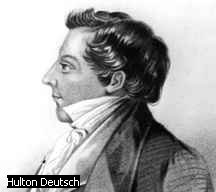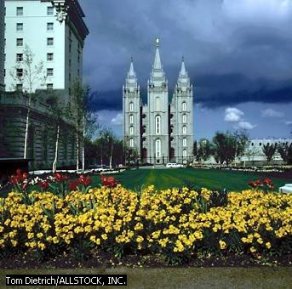
"In matters of
religion and matrimony I never give any advice; because I will not have anybody’s
torments in this world or the next laid to my charge."
Lord Chesterfield(1694–1773), English statesman,
man of letters. Letter, 12 Oct. 1765
(published in Lord Chesterfield’s
Letters to His Godson, no. 73, Appendix, ed. by Earl of Carnarvon, 1890).
![]()
Those who fall into the category of 'Religious Intolerant' seem to have significant problems with the Mormon faith and its adherents. Whether by trickery or force, they make strong efforts to convert Mormons to their particular brand of salvation, generally attempting to defame the Mormon Church in any way possible. Many of those who are anti-Mormon are also, interestingly, anti-Mason as well despite the fact that one is a religion and the other, a fraternity. It's also curious that several of the most outspoken anti-Masons of today are also the most outspoken anti-Mormons.
 A
brief history: The Church of Jesus Christ of Latter-Day Saints, sometimes seen
abbreviated as LDS, was organized by Joseph Smith after he experienced a series
of visions from 1826 to 1830 that called him to restore true Christianity. Smith
translated the Book of Mormon from gold plates that he said the angel Moroni
revealed to him. His new religion drew converts rapidly but they were severely
prosecuted by outsiders. They fled from New York to Ohio and Illinois where a
mob, suspicious of the economic and political power of the Mormons as well as
the Mormon practice of polygamy (having more than one wife), killed Smith and his brother Hyrum in Carthage,
Illinois in 1844.
A
brief history: The Church of Jesus Christ of Latter-Day Saints, sometimes seen
abbreviated as LDS, was organized by Joseph Smith after he experienced a series
of visions from 1826 to 1830 that called him to restore true Christianity. Smith
translated the Book of Mormon from gold plates that he said the angel Moroni
revealed to him. His new religion drew converts rapidly but they were severely
prosecuted by outsiders. They fled from New York to Ohio and Illinois where a
mob, suspicious of the economic and political power of the Mormons as well as
the Mormon practice of polygamy (having more than one wife), killed Smith and his brother Hyrum in Carthage,
Illinois in 1844.
Much is made, primarily by 'religious intolerants', of supposed similarities between certain religious rites of Mormons and the ceremonies of Freemasonry. Conveniently overlooked is the fact that such similarities exist in many other institutions also. Freemasonry, as the oldest fraternity in the world, certainly had its ceremonies and forms copied either consciously or unconsciously throughout the past three centuries. Likewise, its forms and ceremonies did not arrive 'fully-formed' and have elements from institutions, beliefs, and societies well before their own existence. Whether any of this 'proves' that Joseph Smith was not a Prophet or that Mormonism is a false religion is specious at best and is irrelevant to the discussion from a Masonic perspective.
![]()
There is both a past and a present when discussions relative to Freemasonry and Mormonism occur. We'll begin with the past:
Freemasonry became acquainted with the Latter Day Saints at Nauvoo, Illinois in the 2½ years between March, 1842 and October, 1844. Although Freemasonry had been in Illinois since 1805, it's presence there was tenuous and a Grand Lodge formed in 1823 expired very shortly thereafter due to (according to Coil's Masonic Encyclopedia) poor administration. It was not until 1840 that another Grand Lodge was formed but it too met great difficulties, being soon after the Morgan Affair and encountering some jurisdictional disputes over lodges chartered by Missouri.
Joseph Smith had been expelled from Missouri as well and in 1839, settled in Commerce, soon renamed Nauvoo. The population of that location increased from almost nothing to somewhere between 8,000-10,000 souls. In another three years, it was the largest city in Illinois and second only to St. Louis in the whole Northwest. In 1841, Bodley Lodge at Quincy was asked to approve a body of petitioners for a charter at Nauvoo but refused. (There was at this time in many areas a requirement that a new lodge forming in the 'territory' of an established lodge ask permission to do so.) Later in the same year, Grand Master Jonas issued a dispensation and personally instituted the lodge at Nauvoo on March 15, 1842. Some Masonic scholars have indicated that Jonas might have done this for his own personal motives.
In any event, Joseph Smith was initiated the day the lodge was instituted and became a Master Mason the next. Bodley Lodge subsequently charged that the Grand Master had violated Masonic Law in the handling of certain matters surrounding this and on August 11, 1842, the Grand Master suspended the dispensation which had allowed the Lodge at Nauvoo to work.
In a period of less than 6 months, in excess of 250 Masons had been created - an extraordinary number for ANY lodge anywhere at any time. Additional lodges related to that at Nauvoo were 'springing up' in the area without following proper Masonic protocol and there were investigations into the Grand Master's conduct by the Grand Lodge which ordered that the spurious lodges be closed. Those orders were disobeyed and at the Grand Lodge communication of 1844, all Mormon lodges were declared clandestine and all their membership suspended. Coil's Masonic Encyclopedia says:
"These lodges might have continued as clandestine bodies had not the Mormons got into other difficulties. In 1844, a revolt which had been smoldering in the Mormon church broke out, resulting in considerable violence and in the flight of both Joseph and Hyrum Smith. In a few days, the Smiths returned, submitted to arrest and were jailed at Carthage, Ill., where on the afternoon of June 27, 1844, they were lynched and murdered by a mob."
(Masonicinfo Note: Historical accounts indicate that actual death occurred by shooting although apparently lynching was the original intent....)
Myth and legend claims that Joseph Smith used a uniquely Masonic 'signal' to garner assistance from the Masons at the time of his death. These reports persist to this day but were unsubstantiated at the time and remain so now. Additionally, there were conflicting statements from those closest to him physically when his murder occurred. What really happened is obscured by the frenzy of the mob activity, the motivations of the person recounting the story, and the passage of time.
Thereafter, the Mormons made their long and arduous trek across the barren plains and desert, seeking asylum. Brigham Young succeeded to the presidency of the Mormon Church and in the Great Salt Lake Valley, he set his exiled people to work with order and industry, building what was probably the first large-scale system of irrigation in the West.
Because, however, of the stigma of the events in Illinois as well as the moral outrage felt by Masons over the issue of polygamy which the Mormons were then practicing, Grand Lodges in both Nevada and Utah banned Mormons from Masonic membership en masse for several decades thereafter.
![]()
 Today, members of the Church of Jesus Christ of Latter
Day Saints are free to become Masons and vice-versa
without any hindrance whatsoever. A common 'threat' made by some religious
intolerants is that Mormons are not able to advance in their Church or its rites
if they are known to be Masons. Many Masons who are of that
faith will readily attest to the fallacy of this
statement.
Today, members of the Church of Jesus Christ of Latter
Day Saints are free to become Masons and vice-versa
without any hindrance whatsoever. A common 'threat' made by some religious
intolerants is that Mormons are not able to advance in their Church or its rites
if they are known to be Masons. Many Masons who are of that
faith will readily attest to the fallacy of this
statement.
![]()
Regardless of whether there exist similarities between certain Mormon Temple Rituals and Freemasonry (or with anything else for that matter), it is not a concern of Freemasonry. Using this argument against Freemasonry is but another 'red herring' employed by those who seek to defame the fraternity and divert the discourse. Persons with common sense realize that what the members of The Church of Jesus Christ of Latter-Day Saints or any other religious body does or does not do has no effect whatsoever on the functioning of a totally separate and different organization.
Masonicinfo Note: The material above has been necessarily brief. It has been prepared for those who might have heard of some 'link' between the LDS and Freemasonry and were curious. It does not attempt to describe the entire history of Mormonism nor the entire history of Freemasonry during that period but instead is intended as a capsule summary, fairly (we hope) presenting events and circumstances. We trust you have found it unbiased and interesting.
![]()
More on Mormons & Masonry
For many years, an excellent site with an in-depth study on this subject was "The Masonic Moroni - A Page Devoted to the Question of Mormonism & Freemasonry" created by a Mason but not expressing opinions. Sadly, however, with the passage of time that site now no longer exists and no record of it appears on the internet archive website. Ed King 2012.
![]()
|
Related Topics: |
|
In addition, |